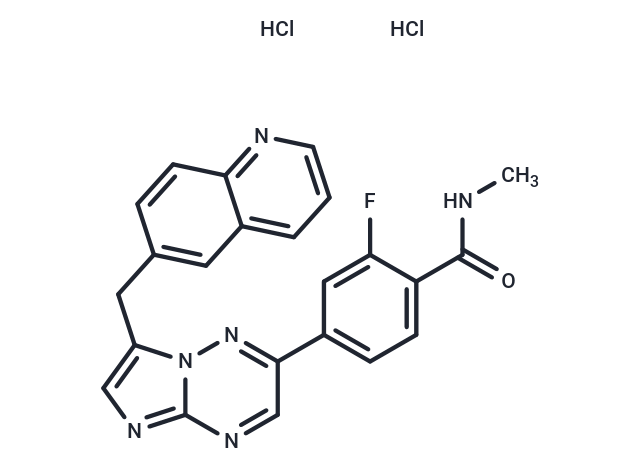Shopping Cart
- Remove All
 Your shopping cart is currently empty
Your shopping cart is currently empty

Capmatinib 2HCl (INC-280 2HCl) is a novel, ATP-competitive inhibitor of c-MET kinase with an IC50 with 0.13 nM.Capmatinib 2HCl exhibits picomolar enzymatic potency and is highly specific for c-MET with more than 10, 000-fold selectivity over a large panel of human kinases. This inhibitor potently blocks c-MET phosphorylation and activation of its key downstream effectors in c-MET-dependent tumor cell lines. As a result, Capmatinib 2HCl potently inhibits c-MET-dependent tumor cell proliferation and migration and effectively induces apoptosis in vitro.

| Pack Size | Price | Availability | Quantity |
|---|---|---|---|
| 1 mg | $37 | In Stock | |
| 2 mg | $50 | In Stock | |
| 5 mg | $64 | In Stock | |
| 10 mg | $79 | In Stock | |
| 25 mg | $148 | In Stock | |
| 50 mg | $271 | In Stock | |
| 100 mg | $453 | In Stock | |
| 500 mg | $1,050 | In Stock | |
| 1 mL x 10 mM (in DMSO) | $98 | In Stock |
| Description | Capmatinib 2HCl (INC-280 2HCl) is a novel, ATP-competitive inhibitor of c-MET kinase with an IC50 with 0.13 nM.Capmatinib 2HCl exhibits picomolar enzymatic potency and is highly specific for c-MET with more than 10, 000-fold selectivity over a large panel of human kinases. This inhibitor potently blocks c-MET phosphorylation and activation of its key downstream effectors in c-MET-dependent tumor cell lines. As a result, Capmatinib 2HCl potently inhibits c-MET-dependent tumor cell proliferation and migration and effectively induces apoptosis in vitro. |
| Targets&IC50 | c-Met (cell-free assay):0.13 nM |
| In vitro | Capmatinib(free base)exhibits picomolar enzymatic potency and is highly specific for c-MET with more than 10,000-fold selectivity over a large panel of human kinases. Capmatinib inhibits human c-MET phosphorylation and c-MET-mediated signaling in cancer cells. Capmatinib inhibits c-MET-dependent cell proliferation and survival, and prevents anchorage-independent cancer cell growth and cell migration. |
| In vivo | INCB28060(free base) shows strong antitumor activity in c-MET-dependent mouse tumor models, even oral treatment of 0.03 mg/kg INCB28060 causes approximately 50% inhibition of c-MET-phosphorylation. Dose-dependent inhibition of tumor growth is observed in tumor-bearing mice. |
| Kinase Assay | c-Met Kinase Assay:The assay buffer contains 50 mM Tris-HCl, 10 mM MgCl2, 100 mM NaCl, 0.1 mg/ml BSA, 5 mM DTT, pH 7.8. For HTS 0.8 μL of 5 mM of INCB28060 dissolved in DMSO are dotted on 384-well plates. DMSO titration suggests that the maximum tolerated concentration of the solvent is 4%. To measure IC50s the INCB28060 plate is prepared by 3-fold and 11-point serial dilutions. 0.8 μL of INCB28060 in DMSO is transferred from INCB28060 plate to the assay plate. The final concentration of DMSO is 2%. Solutions of 8 nM unphosphorylated c-Met or 0.5 nM phosphorylated c-Met are prepared in assay buffer. A 1 mM stock solution of peptide substrate Biotin-EQEDEPEGDYFEWLE-amide dissolved in DMSO is diluted to 1 μM in assay buffer containing 400 μM ATP (unphosphorylated c-Met) or 160 uM ATP (phosphorylated c-Met). A 20 μL volume of enzyme solution (or assay buffer for the enzyme blank) is added to the appropriate wells in each plate and then 20 μL/well of substrate solution to initiate the reaction. The plate is protected from light and incubated at 25 °C for 90 minutes. The reaction is stopped by adding 20 μL of a solution containing 45 mM EDTA, 50 mM Tris-HCl, 50 mM NaCl, 0.4 mg/ml BSA, 200 nM SA-APC and 3 nM EUPy20. The plate is incubated for 15-30 minutes at room temperature and HTRF (homogenous time resolved fluorescence) is measured on a Perkin Elmer Fusion α-FP instrument. The HTRF program settings used are as follows: Primary excitation filter 330/30, Primary window: 200 uSec, Primary delay: 50 uSec, Number of flashes: 15, Well read time: 2000 |
| Cell Research | Cell lines: H441 cells. Concentrations: 0.24,1,4,16,63 nM. Incubation Time: 24 hours. Method:H441 cells are seeded in RPMI-1640 medium containing 10% FBS and grown to complete confluence.Gaps are introduced by scraping cells with a P200 pipette tip.Cells are then stimulated with 50 ng/mL recombinant human HGF to induce migration across the gap in the presence of various concentrations of INCB28060.After an overnight incubation,representative photographs are taken and a semiqualitative assessment of inhibition of cell migration is conducted. |
| Animal Research | Animal Models: Eight-week-old female Balb/c nu/nu mice (Charles River) are inoculated subcutaneously with 4 × 106 tumor cells (S114 model) or with 5 × 106 tumor cells (U-87 mg glioblastoma model). Formulation: INCB28060 is prepared as a 5 mM stock solution in 100% dimethyl sulfoxide and routinely stored at room temperature. Dosages: 3,10,30 mg/kg. Administration: INCB28060 is orally dosed,twice each day. |
| Alias | INCB28060 2HCl, INC-280 2HCl |
| Molecular Weight | 485.34 |
| Formula | C23H19Cl2FN6O |
| Cas No. | 1197376-85-4 |
| Smiles | Cl.Cl.CNC(=O)c1ccc(cc1F)-c1cnc2ncc(Cc3ccc4ncccc4c3)n2n1 |
| Relative Density. | no data available |
| Storage | Powder: -20°C for 3 years | In solvent: -80°C for 1 year | Shipping with blue ice. | |||||||||||||||||||||||||
| Solubility Information | DMSO: 11 mg/mL (22.66 mM) | |||||||||||||||||||||||||
Solution Preparation Table | ||||||||||||||||||||||||||
DMSO
| ||||||||||||||||||||||||||

Copyright © 2015-2024 TargetMol Chemicals Inc. All Rights Reserved.